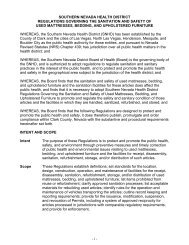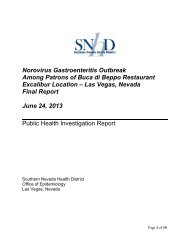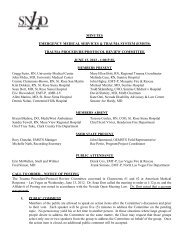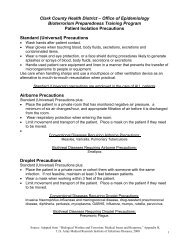Current Trauma Status Report - Southern Nevada Health District
Current Trauma Status Report - Southern Nevada Health District
Current Trauma Status Report - Southern Nevada Health District
Create successful ePaper yourself
Turn your PDF publications into a flip-book with our unique Google optimized e-Paper software.
<strong>Trauma</strong> Glossary<br />
Source: <strong>Trauma</strong> System Agenda for the Future (NHTSA) and The Abaris Group<br />
bypass – transport of an EMS patient past a normally used EMS receiving facility to a designated<br />
medical facility for the purpose of accessing more readily available or appropriate medical care<br />
citizen access – the act of requesting emergency assistance for a specific event<br />
communications system – a collection of individual communication networks, a transmission system,<br />
relay stations, and control and base stations capable of interconnection and interoperation that are<br />
designed to form an integral whole. The individual components must serve a common purpose, be<br />
technically compatible, employ common procedures, respond to control, and operate in unison.<br />
designation – formal recognition of hospitals as providers of specialized services to meet the needs of<br />
the severely injured patient; usually involves a contractual relationship and is based on adherence to<br />
standards<br />
disaster – any occurrence that causes damage, ecological destruction, loss of human lives, or<br />
deterioration of health and health services on a scale sufficient to warrant an extraordinary response<br />
from outside the affected community area<br />
dispatch – coordination of emergency resources in response to a specific event<br />
dry runs – the number of calls for an emergency medical services provider that are cancelled en route<br />
to a scene<br />
emergency medical services for children (EMS-C) – an arrangement of personnel, facilities and<br />
equipment for the effective and coordinated delivery of emergency health services to infants and<br />
children that is fully integrated within the emergency medical system of which it is a part<br />
emergency medical services system (EMS) – a system that provides for the arrangement of personnel,<br />
facilities, and equipment for the effective and coordinated delivery of health care services in<br />
appropriate geographical areas under emergency conditions<br />
EMS diversion – occurs when a hospital’s emergency department cannot accept any additional<br />
patients from ambulances. The ED goes on “divert” and the ambulance must take the patient to an<br />
ED not on divert.<br />
EMS provider – ambulance providers and fire departments (same as pre-hospital provider)<br />
Emergency Medical Treatment and Labor Act (EMTALA) – (Source: American College of Emergency<br />
Physicians (ACEP)) A federal law enacted by Congress in 1986 as part of the Consolidated Omnibus<br />
Budget Reconciliation Act (COBRA) of 1985 (42 U.S.C. §1395dd). Referred to as the "anti-dumping"<br />
law, it was designed to prevent hospitals from refusing to treat patients or transferring them to charity<br />
or county hospitals because they were unable to pay or had Medicaid coverage. In effect, EMTALA<br />
designated emergency departments as one of America's most important health care safety nets.<br />
Under the law, patients with similar medical conditions must be treated consistently. The law applies<br />
Page 89
















